Copeland’s Septet, also known as Hickson Compact Group 57 (HCG 57) and Arp 320, is a group of interacting galaxies located in the constellation Leo.
Even though it is called a septet, it is a group of eight, not seven, galaxies that consists of NGC 3748, NGC 3754, NGC 3750, NGC 3751, NGC 3745, NGC 3753, NGC 3746 and PGC 36010. The galaxies are contained within a 5’ area. The group was named after British astronomer Ralph Copeland, who discovered it in April 1874. It lies at an approximate distance of 400 million light years from Earth.
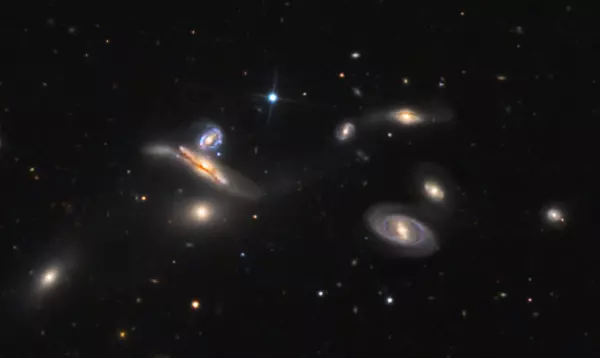
Copeland’s Septet, image: Adam Block/Mount Lemmon SkyCenter/University of Arizona (CC BY-SA 3.0 US)
Copeland discovered the group while working for William Parsons, 3rd Earl of Rosse, as an assistant. He discovered the galaxies with the 72-inch Leviathan of Parsonstown, a historic reflector built by Lord Rosse at Birr Castle. The six-foot telescope was the largest telescope in the world between 1845 and 1917, when the 100-inch Hooker Telescope was built at Mount Wilson Observatory in California.
Copeland named the group “The Septet,” describing the galaxies NGC 3745, 3746, 3748, 3750 and 3753 as “pB [pretty bright],” NGC 3751 as “F [faint],” and NGC 3754 as “vF [very faint].”
Dr. Paul Hickson included the group in his Atlas of Compact Groups of Galaxies (1982) as HCG 57. The galaxy PGC 36010 is a member of the group. Other well-known compact galaxy groups catalogued in the atlas include Stephan’s Quintet (HCG 92) and Seyfert’s Sextet (HCG 79).
Copeland’s Septet lies in the eastern part of Leo, above the lion’s tail. The two brightest members can be seen in a 12-inch telescope, but to see all the galaxies one needs a larger instrument.
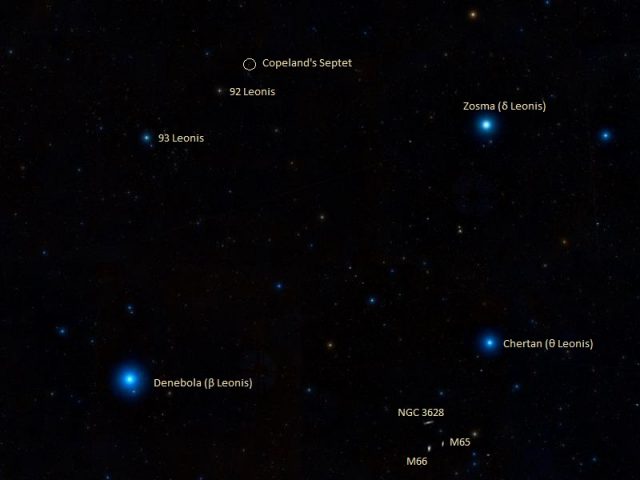
Copeland’s Septet location, image: Wikisky
NGC 3753, Hickson 57a, is the brightest and largest galaxy in the group, with an apparent size of 1.7’ by 0.5’ and an apparent magnitude of 13.7. It is a spiral galaxy with an extended tail. Together with the galaxies NGC 3745, NGC 3746, NGC 3748, NGC 3750 and NGC 3754, it forms the galaxy group Arp 320 and, with the galaxies NGC 3751 and PGC 36010, the Hickson Compact Group 57. NGC 3753 lies at an approximate distance of 388 million light years from Earth.
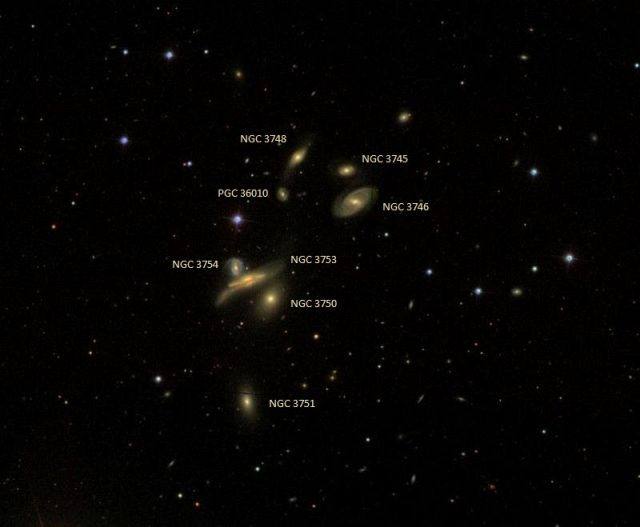
Copeland’s Septet, image: Wikisky
NGC 3746, Hickson 57b, is a barred spiral galaxy with an apparent magnitude of 14.0. It is located about 401 light years from Earth and has an apparent size of 1.1’ by 0.5’.
In 2005, a supernova was observed in NGC 3746, designated SN 2005ba. This was the second supernova event detected in the galaxy within several years. A Type Ia supernova, SN 2002ar, was discovered in it in 2002. It reached a peak magnitude of 16.5.
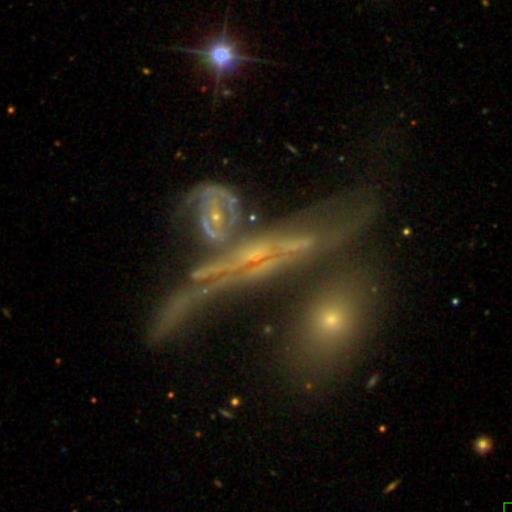
NGC 3750, NGC 3753 and NGC 3754, image: Sloan Digital Sky Survey (CC BY 4.0)
NGC 3750, Hickson 57c, is an elliptical/lenticular (type E-S0) galaxy with an apparent magnitude of 13.9. It lies at a distance of 404 million light years and occupies an area of 0.5’ by 0.4’.
NGC 3754, Hickson 57d, is a barred spiral galaxy with a visual magnitude of 14.3. It is 399 million light years distant and has an apparent size of 0.4’ by 0.3’.
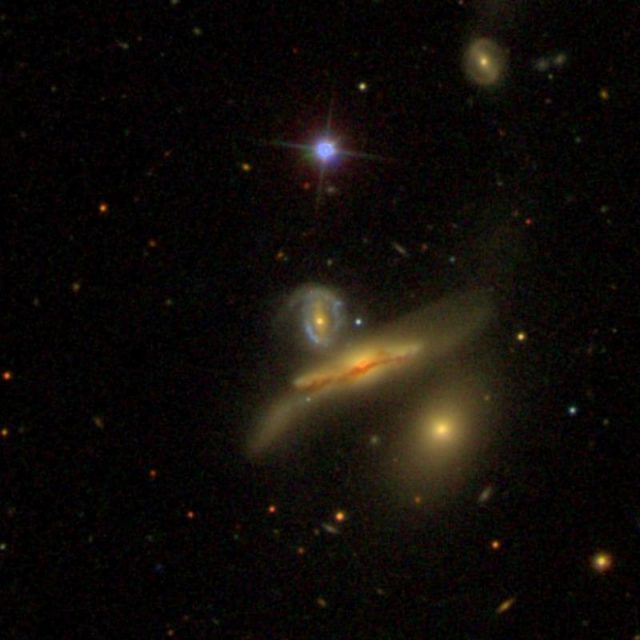
NGC 3754, image: Sloan Digital Sky Survey (CC BY 4.0)
NGC 3748, Hickson 57e, is a lenticular galaxy approximately 392 light years distant. It has a visual magnitude of 14.8 and an apparent size of 0.7’ by 0.4’.
NGC 3751, Hickson 57f, is an elliptical galaxy with an apparent magnitude of 14.3, about 418 light years distant. It occupies an area of 0.5’ by 0.2’.
NGC 3745, Hickson 57g, is a lenticular galaxy about 421 million light years distant. It has an apparent size of 0.4’ by 0.2’ and a visual magnitude of 15.2.
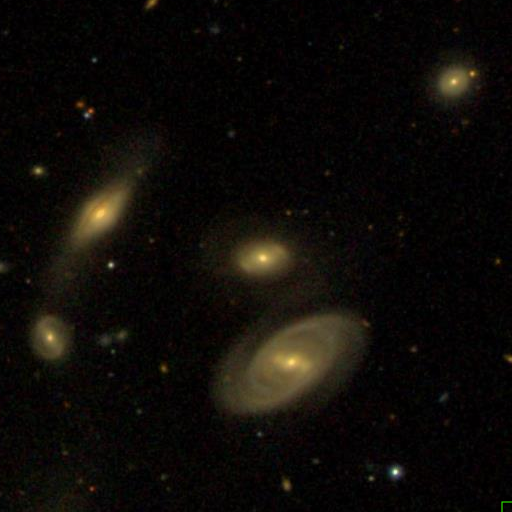
NGC 3745, NGC 3746 and NGC 3748, image: Sloan Digital Sky Survey (CC BY 4.0)
PGC 36010, Hickson 57e, is a barred spiral galaxy with a visual magnitude of 17.4. With an apparent size of 0.3’ by 0.2’, it is the smallest galaxy in the group.
Hickson Compact Group 57
| Galaxy | Hickson | Right ascension | Declination | Type | Apparent Magnitude | Size |
| NGC 3753 | 57a | 11h 37m 53.9s | +21°58′ 53″ | spiral | 13.7 | 1.7’ x 0.5′ |
| NGC 3746 | 57b | 11h 37m 43.6s | +22°00′ 34″ | barred spiral | 14.0 | 1.1’ x 0.5′ |
| NGC 3750 | 57c | 11h 37m 51.6s | +21°58′ 27″ | lenticular/ elliptical | 13.9 | 0.5’x0.4’ |
| NGC 3754 | 57d | 11h 37m 54.9 | +21°59′ 08″ | barred spiral | 14.3 | 0.4’ x 0.3′ |
| NGC 3748 | 57e | 11h 37m 49.2s | +22°01′ 33″ | lenticular | 14.8 | 0.7’ x 0.4′ |
| NGC 3751 | 57f | 11h 37m 54.1s | +21°56′ 10″ | elliptical | 14.3 | 0.5’x0.2‘ |
| NGC 3745 | 57g | 11h 37m 44.6s | +22°01′ 15″ | lenticular | 15.2 | 0.4’ x 0.2′ |
| PGC 36010 | 57h | 11h37m 50.50s | +22°00′ 45″ | barred spiral | 17.4 | 0.3’x0.2’ |